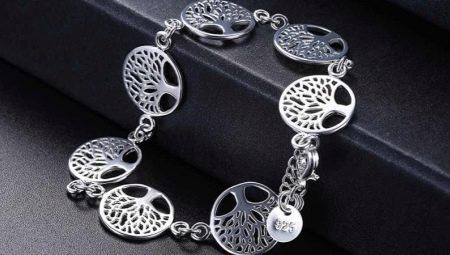Elegant jewelry does not go out of fashion and is appreciated not only for its beauty, but also for its high durability. At all times, people believed that buying silver alloy items is a good investment of free cash, as precious metals are constantly growing in price. Jewelers know that Ag metal physically is a very plastic material, therefore, alloys are used to make jewelry, thanks to which precious metals receive a certain share of hardness, and products from them are able to maintain a given shape.
To indicate the proportion of impurities in precious metals, a specially developed probing system is used. Thanks to the sample applied in the form of a mark on a silver product, one can understand how many grams of pure silver are present in 1 kilogram of alloy.
A high level of sample means the content of a large amount of precious metal in the finished product.
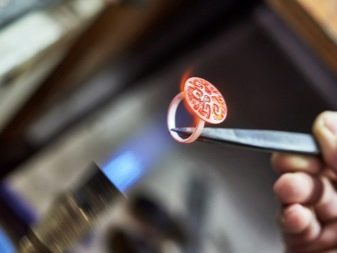

Features
It is known for certain that the 925 silver alloy contains at least 7.5% Cu metal and 92.5% Ag metal, i.e., copper and silver. Copper gives strength to silver, allowing melt products of high quality. Today, 925 test means that you have silver, the quality of which is the highest of all possible. The metal whose sample is listed as s925 has the following features:
- this silver alloy is easy to jewelry;
- metal is ductile, thanks to this, any elements of an increased level of complexity can be made of it;
- silver alloy can be coated on top with a thin layer of gilding.
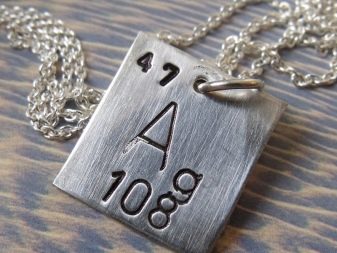
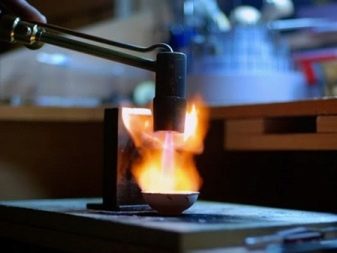
Performing an alloy of 925 samples, copper is added to pure silver, but as a result, the appearance of the products loses its luster over time and may darken upon contact with water. To improve the properties of the jewelry alloy, zinc, platinum, as well as germanium or silicon are added. Such additives can improve the color gamut of finished products and their characteristics. In the world of jewelers, silver material 925 can be designated as follows:
- sterling or sterling silver;
- standard silver or silver standard.
In addition to the 925 sample, there is also 999 sample which has more excellent qualities and high value among jewelers. However, you are unlikely to find products from such a metal in the free sale, because expensive masterpieces are made of 999 silver.

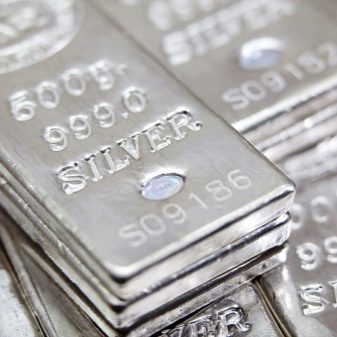
Composition and properties
Pure silver, free from impurities, looks like a bright shiny metal of a whitish hue. It has a high reflectivity, since its entire surface is mirrored and reflects approximately 95-97% of the color spectrum. For its mirror properties, silver alloy is used not only in jewelry, but also in the manufacture of mirrors.
Pure silver has a density of 10.4 g / cu. cm, this is half the density of gold, but slightly less than the density of lead. In addition, silver is denser and weighs more than, for example, iron or copper.
The specific gravity of such a metal as silver 925 is 108 a. eat.
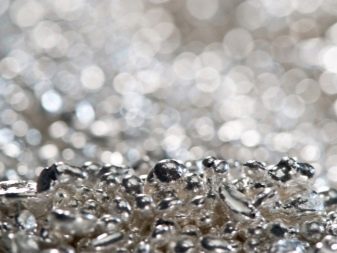
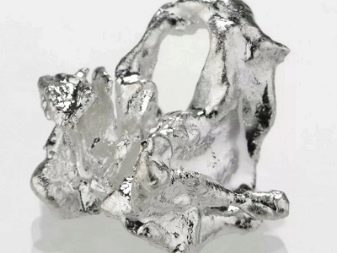
Silver has certain physicochemical properties:
- the highest thermal conductivity, in comparison with other metals;
- high ability to conduct electric current;
- the lowest melting point compared to other precious metals - 960 ° C;
- Ag metal is inert, it does not interact with other metals in a natural environment, but is most capable of chemical reactions, among other valuable metals;
- Ag metal is soluble in mercury, nitric and concentrated sulfuric acid, if heated to a hot state, but insoluble in hydrochloric acid.
When silver metal interacts with zinc, platinum, copper, silicon, germanium, the alloy acquires various unique color shades, and its oxidizing ability also increases.

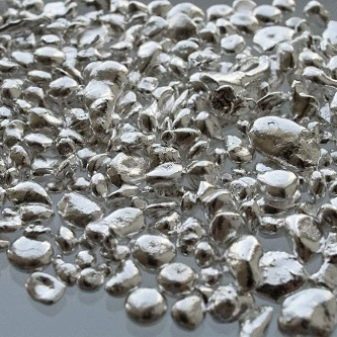
Differences from sample 875
Quite often jewelry with 875 sample indicating that the alloy contains metals - 12.5% Cu and 87.5% Ag. Comparing samples 925 and 875, we will see that 875 sample is not considered high quality due to the high level of copper additives. Objects made of alloy 825 samples may have reddish or straw halftones, and may also darken in contact with a wet surface. Silver alloy 825, in addition to copper, may contain silicon, germanium or platinum, which improve the characteristics of the material and how the finished product looks. However, if the material contains platinum, the cost of the jewelry will be much higher than if it were made only on the basis of Cu and Ag metals.
Due to the low price, 875 silver alloy is in great demand and is used for the production of jewelry, decorative crafts, tableware. As for jewelers, behind the scenes they attribute 925 silver to a high-grade alloy, and 875 metal to second-class material. Therefore, expensive jewelry will always be made of sterling silver alloy 925, and table silver will have a mark with the number 875 - this is the difference.

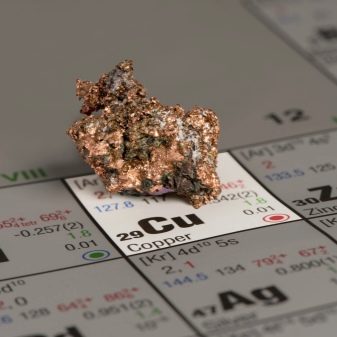
Species overview
Making a combined composition of the material, jewelers noticed that the way the metal looks depends on its ingredients. Through experiments, not only various types of alloys appeared, but also methods for their decorative processing. The most popular are the following types of silver.
Blackened
The method of blackening appeared in the days of Ancient Russiawhen silverware was decorated with saturated black patterns.If you combine sulfur, lead, copper and pure silver in certain proportions, you get a substance that in the old days was called "mob." The finished product was subjected to artistic engraving, after which it was required to be heated until the composition for blackening was dissolved. The result of this work was a product that combines silvery light and rich dark shades.
Silver jewelry, household items, utensils, prints and so on were decorated with this method. Especially great was the demand for blackened silver in the 17th century. Products made of blackened silver alloy were particularly durable and did not need constant cleaning.

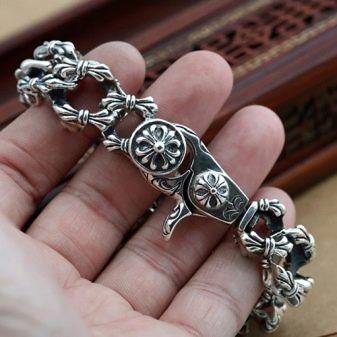
Oxidized
Another kind of blackening that achieved by combining Ag metal and mineral S. Different from blackened silver, oxidized blacking was not so stable, since blacking was achieved by obtaining a special oxide film, which quickly became unusable after cleaning the product. The cost of oxidized silver is the same as that of blackened silver, but when buying it was important not to confuse them, since the coating resistance is different.
Due to the manufacturing technology, oxidized silver could give shades of blackening from dark violet to black, and when polishing the product, the convex parts became shiny and light, and the concave details of the pattern had a certain blackening effect.
As a rule, small articles are decorated with oxidized blacking - earrings, pendants, pendants, chains or bracelets.
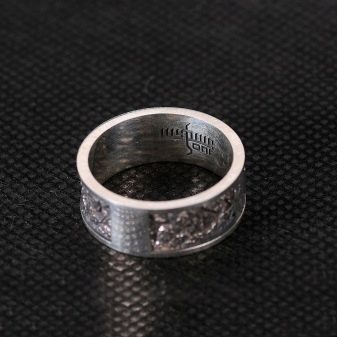
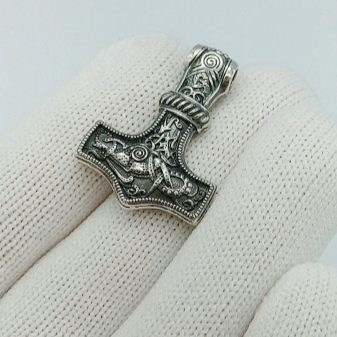
Matte
It is obtained by eliminating the natural metallic luster of the product, which gives it a certain sophistication and resistance to darkening. Achieve this effect by sandblasting the product or etching silver in special chemical solutions.
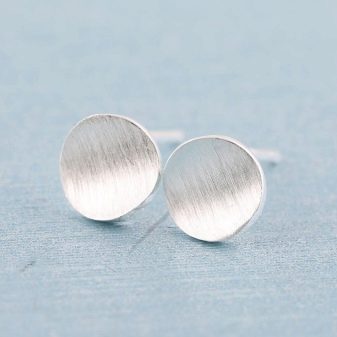
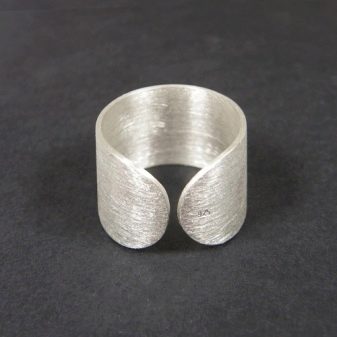
Gilded
Obtained by applying a thin layer of gold to a silver alloy. This treatment adds value to the finished product, gives it a sophisticated look and increases the natural resistance to oxidative processes. Not only jewelry but also cutlery is gilded.that can withstand their placement in an acidic and salty environment and do not lose their original appearance, while a product from ordinary silver would react by a color change.
In addition to the above methods, silver is decorated with enamel or alloys with metal are made with rhodium. Such silver looks especially bright and is distinguished by its pronounced white color.


Marking
In pre-revolutionary Russia, the mark on silver products was put in two digits, and after the revolution it already looks like a three-digit number.
- After the revolution 875 standart it was designated, in addition to numbers, by a letter and a sign of state supervision on probing, looking like a female kokoshnik. In the days of the USSR, the samples were marked with the sample number and the impression of the star. Now such products are in high demand - they are bought by collectors.
- Marking 925 tests it was often accompanied by the inscription sterling silver, since this metal was called sterling silver by the name of the English silver coin of the same name, on which it was possible to purchase luxury goods made of 925 sterling silver. When marking high-quality 925 silver, one can also find additions such as ster, sterling. Silver 925, in addition to this inscription and a three-digit number, can also be marked with some image adopted in the country where the product was made.
- On the gold plated silver products you can see sample 5925, which means that the product uses 925 silver and 5 microns of gold on top.
In jewelry stores, silver can be marked with a mark with samples officially recognized throughout the world - 999, 960, 925, 875, 830, 800. The remaining three-digit codes, for example, 923, 926, 929, 952, are not universally recognized.
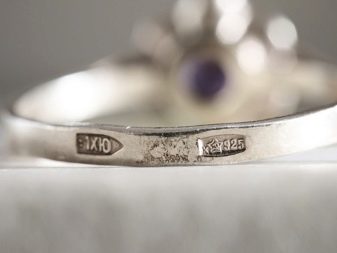
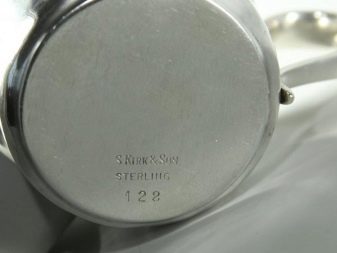
Application
925 silver alloy is used for the manufacture of jewelry and bijouterie, which in their beauty are not inferior to models made of gold. Also made of silver make paintings, household items, cutlery, various types of furniture and stationery. Silver products at all times were in demand and were considered an excellent gift.
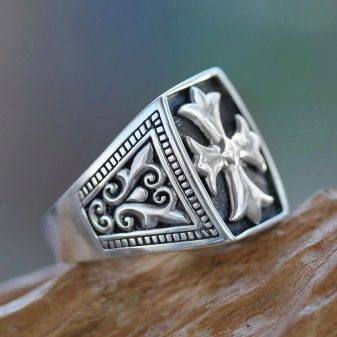

Cost per gram
The determination of the cost of 1 g of silver is as follows:
- find out the cost of 1 g of silver, according to the Central Bank of the Russian Federation on the date we need;
- the sample determines the level of silver in the product.
For example, we define the cost of 1 g of 925 sterling silver as of January 23, 2020: 36.71 / 1000x925 = 52.44 rubles. / g It remains only to multiply this number by the weight of the product to determine its market value.

Care Tips
To make silver items look attractive, behind them you need to be able to care at home. Care consists in regularly cleaning the product. using certain formulations and napkins - You can purchase them at any jewelry store.
The silver product is placed in a cleaning composition, kept there for some time, washed with water and dried with polishing wipes. In this way, silver products that do not have inlays are cleaned. In addition to cleaning, solutions provide a thin film on top of the alloy that protects the metal from oxidative reactions.
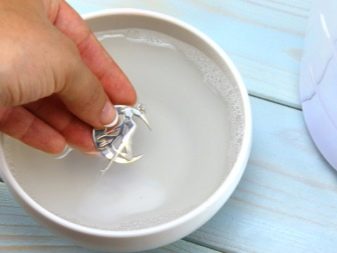
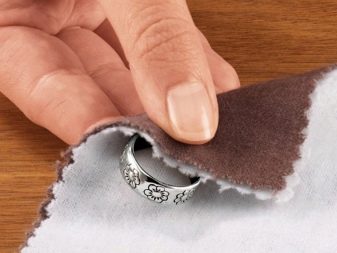
There are other methods for cleaning silver jewelry:
- ammonia is diluted with water in a ratio of 1: 10 and in solution the product is washed or wiped with a cloth moistened with this composition;
- severe contaminations are cleaned with tooth powder or toothpaste using a soft-bristle brush;
- soda is dissolved in water in a ratio of 2: 10, the product is washed with the resulting solution;
- soap solution (20 g of soap per 1000 ml of water) also cleans silver things well.
Care for silver is carried out carefully and make sure that concentrated solutions of acids do not get on the metal, from which silver can darken, reacting with them.
Performing housework, at home or in the garden, it is better to remove silver alloy products for this time, since their surface will be covered with small scratches, which will lead to a loss of shine - the decoration will have to be polished.
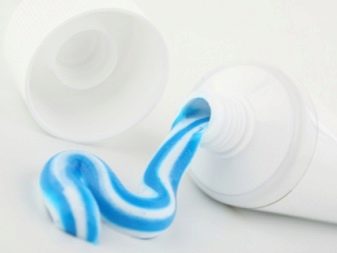
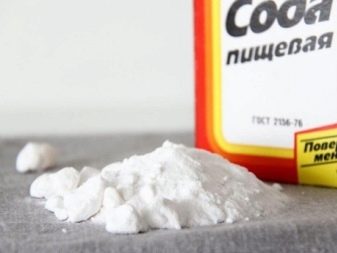
See the next video for the value of the sample on jewelry.
